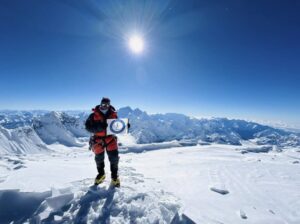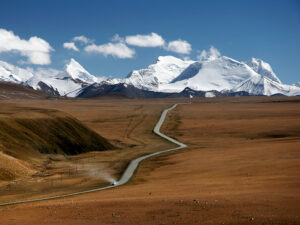So far, one group has requested a permit from Pakistan authorities to visit K2 Base Camp this winter. The visitors are not there to climb the mountain, nor are they trekkers. The small team plans to retrieve the remains of Matthew Eakin, who perished on the Abruzzi Spur this summer.
Bodies of deceased climbers are rarely retrieved from K2, especially in winter. Here is the story of what led to this unusual expedition.
Two accidents
On July 23, 2022, one day after an unprecedented wave of 145 climbers jammed K2’s upper slopes, Matthew Eakin of Australia stood on the summit completely alone.
At the time, reports were sketchy and confusing. This is what we know: Eakin reached Camp 3 two days earlier with Canadians Richard Cartier and Justin Dube-Fahmy. On the following day, July 22, they proceeded to Camp 4, but Cartier eventually turned around in cold, windy conditions. Dube-Fahmy spent some hours in Camp 4 trying to warm up, then descended too.
Eakin waited for the crowds coming down from the summit to pass, then he proceeded up himself, eventually succeeding. He communicated the good news to Base Camp and to his family. He also took photos with his cell phone, which has not yet been retrieved.

Matthew Eakin, second from the right, in K2 Base Camp. Photo: Justin Dube-Fahmy
It was during the descent that tragedy struck, in two separate accidents. Richard Cartier fell at some point below Camp 1 on July 23. Justin Dube-Fahmy, following some distance behind, didn’t notice. He only raised the alarm back in Base Camp, when he discovered that his partner was not there.
Meanwhile, Matthew Eakin kept contact with Base Camp and his family during the first part of the descent, as he down-climbed the Bottleneck past Camp 4. His last contact took place at Japanese Camp 3 (6,960m), where he took a break and then resumed his descent.
No one knows what happened. Possibly he fell after slipping or when a rock struck him. He never made it back to Base Camp.

Matthew Eakin was an experienced climber. Above, on Manaslu. Photo: Bibek Pandey
Avalanche buried remains
Cartier’s remains were taken off the mountain and buried near Advanced Base Camp (ABC). Eakin’s body was found slightly above ABC on July 25. He probably fell from below Camp 2.
“Two men found Matt, and just after they left for help, a small avalanche struck and buried him,” Eakin’s sister Danielle Bonnington wrote. “Over the following two days, teams attempted to dig Matt out of the snow and ice but despite their very best efforts, were unsuccessful. Matt remains buried, but his location is well known.”
The only option was to wait for that snow to melt or to blow away. And that is the reason for going in winter.

Matthew Eakin. Photo shared by his family
K2 is the driest at this time of year. Typically, the mountain is bare on all its lower sections. Several climbers told ExplorersWeb that Eakin’s body may be encased in ice but it is not buried in deep snow.
Below, K2’s ABC in winter, as filmed by Alex Txikon:
The recovery team will leave at the beginning of February and spend three weeks in the Karakoram. They know the exact coordinates of the body’s location and should be able to find it easily. There is a secondary reason for making the effort: Eakin’s remains are close to the main route and too exposed to passing climbers.
The final reason that Eakin’s family has chosen to travel all the way to K2 at the coldest month of the year: They want to bury him properly. They have fundraised to help finance the journey.
Double trauma for families
Recovering the remains of climbers who died at high altitude is becoming more common in Nepal, thanks to the availability of skilled rescuers and abundant resources for aerial evacuations, especially on Everest and Manaslu.
In Pakistan, on the contrary, aerial help is rare and expensive. Climbers who perish high on a Karakoram 8,000’er are typically moved away from the route and buried in the snow or down a crevasse. Yet the families of the lost climbers then suffer a double blow. Not only has their loved one died, but they lack a physical body to mourn, which increases the trauma for many.
Regular readers may remember the case of John Snorri, Ali Sadpara, and Juan Pablo Mohr, who died on winter K2 in 2021. Climbers, including Sadpara’s son Sajid, only found their bodies the following summer. Sajid lowered his father and buried him below the Bottleneck.
Snorri’s widow Lina specifically stated that she didn’t want to put rescuers at risk trying to retrieve his husband’s remains. If conditions were safe, she asked that he be moved off the main climbers’ route and buried by his friends. Mohr’s family traveled to Base Camp and performed a memorial ceremony there.

A climber in front of Gilkey Memorial — a pile of rocks where climbers who perished on the mountain are commemorated with plates, sometimes including base camp dishes with their names engraved on them. Photo: Tente Lagunilla
Eakin, however, is very close to Advanced Base Camp. His accident was probably similar to the one that killed Sergi Mingote, also in the winter of 2021. Other climbers who were on the mountain and saw him fall retrieved Mingote’s remains, which were brought back home to Catalonia.
The team in charge of bringing down Matthew Eakin’s body will have to cover a similar distance on the moraine close to ABC. They will not need to climb. Repatriating the body back to Australia will be too expensive. But hopefully, before spring, Matthew Eakin will rest at the foot of the mountain, close to his climbing partner and others who have died in similar circumstances.






